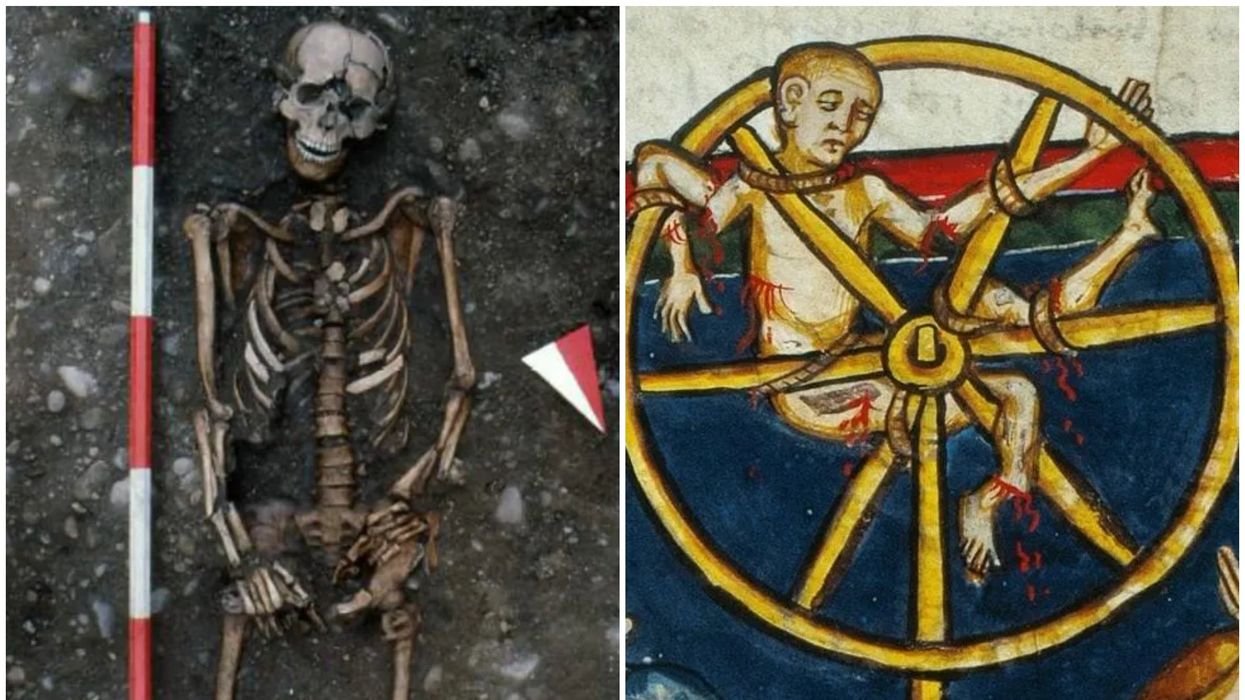Science & Tech
Harriet Brewis
Apr 21, 2024

Archaeologists unearthed the skeleton of a man who had suffered an unimaginably gruesome end
(Mibac - Soprintendenza ABAP Milano/Public Domain)
History buffs will be all too familiar with the torture devices deployed in centuries past.
From the Tower of London’s famous “rack”, to being boiled alive (see episode one of Shōgunfor that one), no method was too gruesome for our bloodthirsty ancestors.
But these stomach-churning tactics don’t just exist in documents and stories, archaeologists have uncovered the real-life remains of hapless sufferers of such brutality.
And in 2019, a team of experts in Milan, Italy, unearthed the skeleton of a man who had suffered one of the worst deaths imaginable.
The 13th-century victim was aged between just 17 and 20 when he met his end, a 2019 study published in the Journal of Archaeological Science revealed.
Initial analysis of his bones showed that he had suffered from wounds symmetrically positioned across his arms and legs – hinting at the intentional nature of his injuries, as IFL Sciencenotes.
The researchers, from the University of Milan, concluded that the man had most probably been tortured using what was known as the “Catherine wheel”, “breaking wheel” or, simply, “the wheel”.
For the uninitiated, the wheel was a method of execution first used by the ancient Romans under the notorious emperor Commodus.
According to Geoffrey Abbott, author ofWhat a Way to Go, Commodus would have a wheel studded with iron spikes rolled over the bodies of his victims as they lay bound to a bench.
The executioner would then pound the wheel further into their bodies to ensure the maximum amount of pain.
Abbott, a former Tower of London Yeoman Warder, noted in his book that two groups of people tended to be subjected to the wheel: slaves and Christians.
And, over the centuries, different executioners would try out different techniques using the device.

In some cases, torturers battered victims by dropping the heavy wooden wheel onto their limbs. Then, once the body was sufficiently broken, they would weave the limbs in and out of the wheel spokes or tightly fasten the body to the wheel using a rope.
Further injuries were then inflicted using other weapons including blades, fire, whips, and red-hot pincers – after which the wheel was mounted on a pole and hung like a flag, IFL Science reports.
The dying victim would then hang there for days, or even weeks, until they eventually succumbed to their wounds or were put out of their misery.
And whilst you might expect such extreme torture was reserved only for those accused of the most heinous crimes, in northern Italy – where the University of Milan found their 13th-century man – this kind of capital punishment was deployed on people suspected of being plague spreaders.
“The victim of the wheel could have been considered as different by his contemporaries, and possibly this discrimination may have been the cause of his final conviction, as he could have been sacrificed, being a ‘freak’, by an angry crowd, as a plague spreader,” the researchers wrote in their paper.

Further forensic investigation into the skeleton revealed unusual fractures at the base of his skull, which was most likely the result of a sharp force trauma from a heavy weapon during a “clumsy decapitation".
If the Milan team’s conclusions are correct, it means they have unearthed the first documented archaeological evidence of a human being tortured by the wheel in Medieval northern Italy, and possibly the world.
We just hope that poor guy is now resting in peace.
Sign up for our free Indy100 weekly newsletter
Have your say in our news democracy. Click the upvote icon at the top of the page to help raise this article through the indy100 rankings
Top 100
The Conversation (0)













